One of two of the groups of labyrinth fishes, gouramis, make for colorful additions to community aquariums.
Provided you stay on top of routine tank maintenance, they’re easy to take care of, allowing even novice aquarists to enjoy their beauty.

Gouramis come from Asia, India, Korea, and Pakistan. In the wild, the fish inhabit shallow waters, especially rice paddies.
Such low-lying streams are often deficient in oxygen, which led to the evolution of the labyrinth organ.
Along with bettas, gouramis have a labyrinth organ in addition to their gills. Positioned above the gills, the cavity features numerous bony plates covered in lamellae. The lamellae receive a steady blood supply that carries supplemental oxygen to the remainder of the body.
Gouramis “gulp” air from the water’s surface. In other freshwater fish, such behavior signals stress, and you might be inclined to panic.
As a gourami owner, you WANT to see your labyrinth fish cruising the top of the tank. It’s normal behavior.
Such an adaptation may even save these fish from accidents.
As long as the fish remain in a moistened condition, they can survive out of the water! The labyrinth organ keeps oxygen flowing through the system during sudden drought conditions.
[toc]
The Unique Gourami
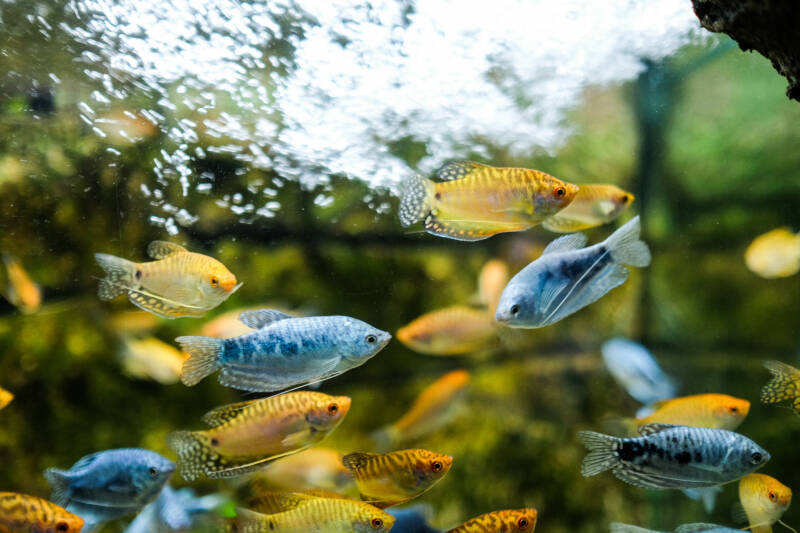
The labyrinth organ isn’t the only thing setting gouramis apart from other colorful freshwater fish. (Though it’s undoubtedly a rarity!)
These little fish have a couple of other features that make for great conversation starters.
Impolite Behavior?
When your gourami takes in air at the surface to bathe the labyrinth organ, they also swallow water.
You may then notice them hovering near the top of the tank and spitting when you walk by, especially if it’s near feeding time.
Certain types of gouramis developed this spitting behavior to knock insects from the water’s surface. With a quick flick of their powerful caudal fins, they could then jump out to snatch up the stunned insect.
You want to keep crucial breathing space at the top of the tank, but you’ll need a sturdy lid at the same time.
Watching your gourami jump for their dinner might be entertaining, but the last thing you want is to find your fish flopping around on the floor.
Spawning: The Bubble Nest
Many types of gouramis create elaborate bubble nests at the surface of the tank as part of their courtship ritual.
Males blow bubbles to form a cozy residence for their eggs-to-be. The bubbles adhere to one another to create a floating structure.

Only have a single male in your tank? Don’t fret if you see a nest appear in the corner of the tank.
Male gouramis create bubble nests in the absence of a female to demonstrate contentedness. Rather than rushing to buy a female, congratulate yourself on a job well done!
Other types of gouramis skip the nesting process. They opt to mouth-brood their eggs.
And it may be the father that carries the young! He’ll skip weeks of meals to protect the developing young.
Whichever method your gourami chooses, they’re all model parents.
Popular Types of Gouramis
Most aquarists would never dream of throwing their colorful aquarium denizens on the grill, but gouramis often find themselves raised for the table.
In many Asian regions, Snakeskin, Kissing, and Giant Gouramis feature prominently on menus. (Fun little gourami fact)
Gouramis make stunning additions to freshwater aquariums. The flattened oval bodies come in an array of colors.
They’re also playful fish, interacting with you and demonstrating individual personalities. As they come to the surface, they learn to recognize you.
There are over 130 species of gouramis currently recognized. That’s a lot of variation to choose from!
Some are more vibrant than others, but each features unique qualities that are sure to appeal to aquarists of every level.
1. Chocolate Gourami (Sphaerichtys osphromenoides)
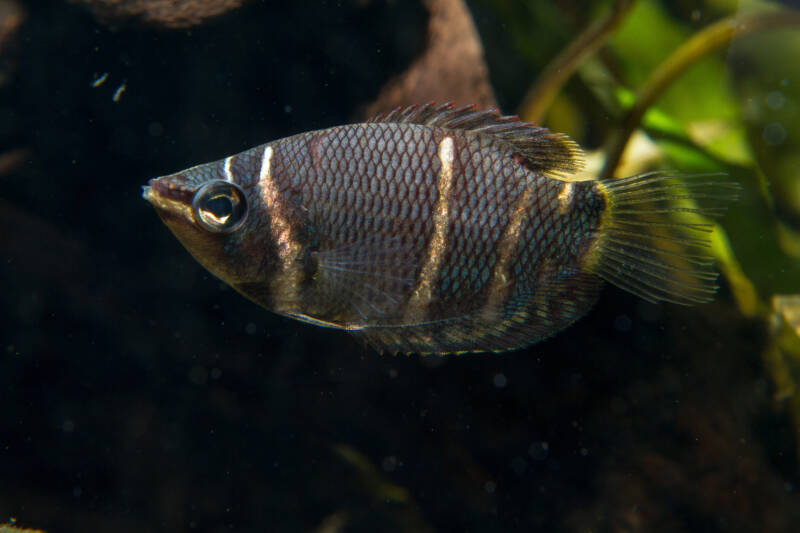
- Difficulty: Easy
- Temperament: Peaceful
- Diet: Omnivore
- Tank Size: 30 gal (114 l)
Chocolate gouramis feature the dark brown color you’d expect with vertical stripes down their sides.
They’re not the easiest types of gouramis to find, but they make sweet-tempered additions to peaceful community tanks.
You’ll want to provide plenty of foliage for your chocolates to swim around and hide within. They have a shy demeanor, and more aggressive fish often bully them.
They’re also slow-swimmers, so keep an eye on them during feeding time, or they may end up starving.
Chocolate gouramis mouth-brood instead of building bubble nests. The female holds the eggs for two weeks until they hatch. The male sets up a protective watch over the female during that time, guarding her until the fry are ready to venture out.
2. Dwarf Gourami (Trichogaster lalius)
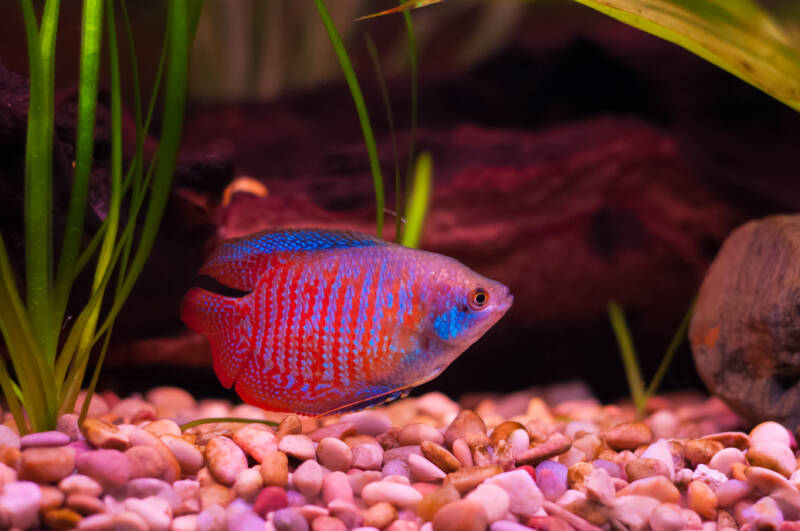
- Difficulty: Easy
- Temperament: Peaceful
- Diet: Omnivore
- Tank Size: 10 gal (38 l)
Dwarf gouramis come in various colors, though it’s only the males that show the brilliant shades. The females come in a subdued silver.
There’s a catch, though: if you want the best hues, you’ll need at least one female, so your male has someone to show off for.
One of the smallest types of gourami, dwarfs, only reach a length of about 2 inches (5 cm) when fully grown.
As they tend to be reserved and slow, make sure you choose their tank mates appropriately. You don’t want to see them snatched up by a larger fish.
While peaceful, males don’t tolerate sharing space. You’ll end up with aggressive fighting if you attempt to put two males in the same tank, even if they’re different color morphs. Try to avoid it, or opt for a much larger aquarium.
3. Honey Gourami (Trichogaster chuna)
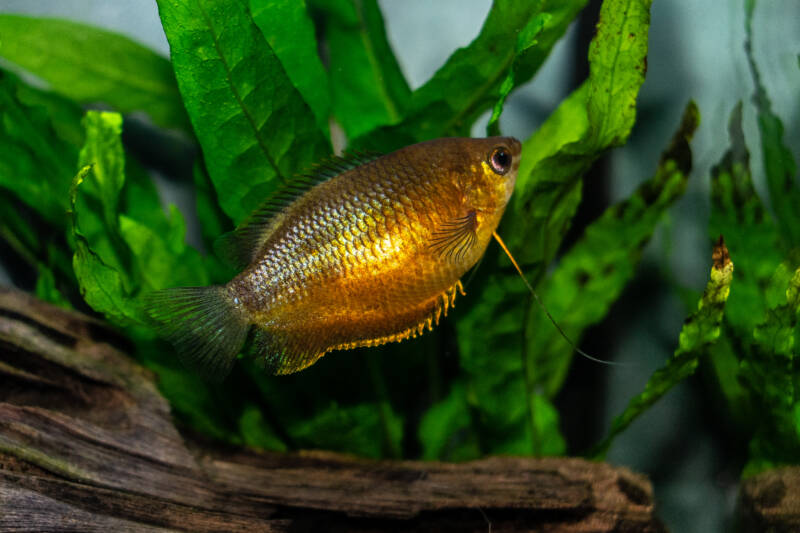
- Difficulty: Easy
- Temperament: Peaceful
- Diet: Omnivore
- Tank Size: 20 gal (76 l)
While honey gouramis may not be as vibrant as some of the other types available, that soft shade of amber looks gorgeous against a wall of vibrant green plants.
Once again, only the males carry the golden-yellow color, with females staying a more delicate silver.
Honey gouramis make excellent choices for novice aquarists. They tend to be one of the hardiest members of this group.
For an unknown reason, they aren’t as susceptible to Dwarf Gourami Disease, and they hold up better against subtle shifts in water conditions.
If you want the best coloration from your honey gourami, keep it happy- the better the health and well-being, the brighter that gold shade. So provide plenty of hiding places, the best food options, and peaceful tank mates.
4. Kissing Gourami (Helostoma temminickii)
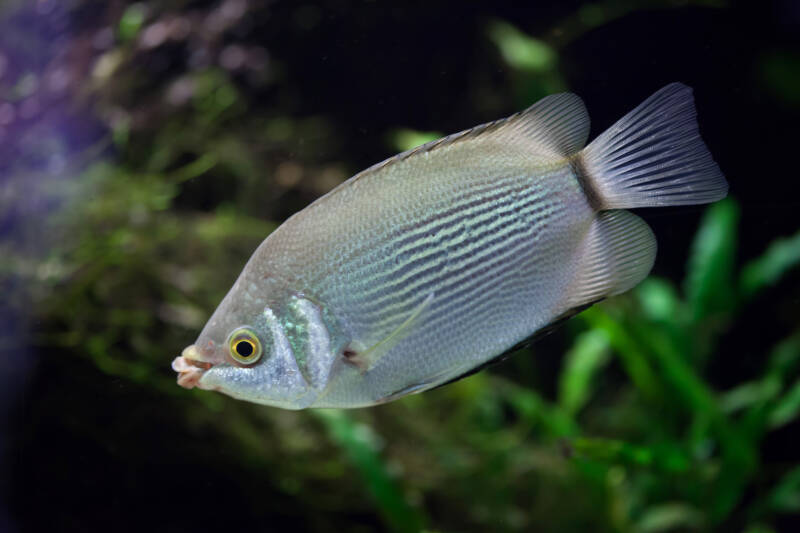
- Difficulty: Easy
- Temperament: Semi-Aggressive
- Diet: Omnivore
- Tank Size: 55 gal (208 l)
Kissing gouramis come in three different color varieties: pink, silvery-green, and mottled.
The silvery-green type is the most commonly available, though the pink type is the fish most people think of when they hear the name.
Kissing gouramis earned their name from their behavior of “locking lips”.
It might appear enchanting, but your fish are actually engaging in a wrestling match over territory. Even worse, your gourami employs the same tactic to ram tank mates and bite at their scales or fins!
Despite the hidden aggression, kissing gouramis lean toward the herbivore side of the menu.
They strip algae from the surfaces of plants and decorations. They may also pick at the softer plants in your aquarium, so choose your greenery carefully.
5. Licorice Gourami (Parosphromenus deissneri)
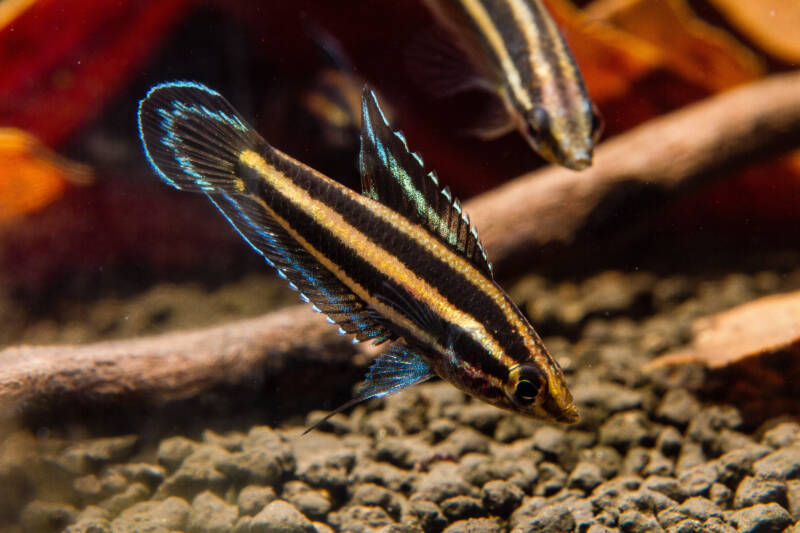
- Difficulty: Hard
- Temperament: Peaceful
- Diet: Omnivore
- Tank Size: 10 gal (38 l)
Licorice gouramis aren’t the most common type out there. They’re also not the easiest to care for.
They come from blackwater creeks in Indonesia, where decaying plants drop the pH to the range of 3.5-4.0.
You’ll have to work at keeping your tank water as soft and acidic as possible.
Male licorice gouramis have tails of red, gold, and blue set against black and silver scales.
When showing off for females, they wave their tails proudly. You’ll want to keep your aquarium as dim as possible to make the best of those colors.
Licorice gouramis are tiny. Full-grown, they don’t reach more than 1.5 inches (3.8 cm). It’ll present a challenge to keep water conditions precise, but it makes them perfect for a nano aquarium.
Just don’t let water quality slip – they’re HIGHLY sensitive!
6. Moonlight gourami (Trichogaster microlepis)
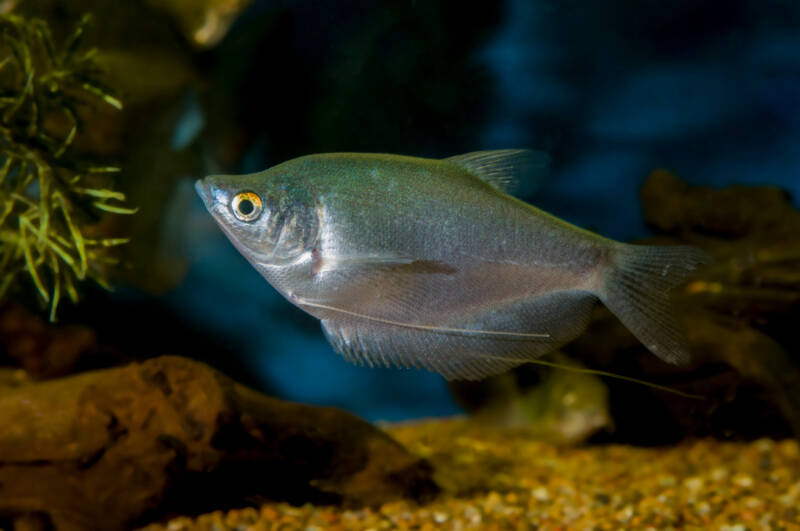
- Difficulty: Easy
- Temperament: Peaceful
- Diet: Omnivore
- Tank Size: 20 gal (76 l)
Moonlight gouramis get their name from the iridescent shine of their scales. Even in full daylight, they appear to glow like the moon on a pond.
As they age, their scales take on a slight greenish tinge that heightens the effect.
Moonlights have dramatic filaments depending on their ventral fins. It provides an elegant appearance.
Similar to freshwater angelfish, though, it makes them a target to nipping tank mates. You’ll want to pair them with peaceful fish who can keep their teeth to themselves.
Moonlight gouramis are one of the larger types in the group, reaching 5,1 inches (13 cm).
They do fine on their own, but if you want to keep a pair or group, increase your tank size accordingly. You want plenty of room to give those sweeping filaments their proper space.
7. Paradise Fish (Macropodus opercularis)

- Difficulty: Easy
- Temperament: Aggressive
- Diet: Omnivore
- Tank Size: 20 gal (76 l)
As you might expect from their name, paradise fish look like a tropical dream. Their trailing fins feature a rainbow of colors, giving them a ribbon-like appearance.
They’re active swimmers, too, keeping those colors dancing through the water.
Unfortunately, paradise fish don’t have a relaxed temperament to match their name.
Unrelenting bullies, they’ll actively chase any fish that enters the territory they’ve set up in the tank. And if two males encounter each other, they’ll fight to the death!
Choosing tank mates carefully is crucial with paradise fish. Avoid guppies at all costs. Your paradise fish may mistake them for another of their kind, leaving your guppy at the mercy of a battle they won’t win.
8. Pearl Gourami (Trichopodus leerii)

- Difficulty: Easy
- Temperament: Peaceful
- Diet: Omnivore
- Tank Size: 30 gal (114 l)
Pearl gouramis sport a sleek black line down their middles, with white pearlescent spots over the remainder of their scales.
They’re among the larger types of gouramis, allowing that stunning pattern to take front and center within the aquarium.
Aquarists love pearls for their hardy nature. They adapt to changing water conditions without too much trouble, and they’re easy to feed.
As long as you pair them with similar-size tank mates (and select for peaceful natures), they do well.
Pearl gouramis serve another useful function in home tanks. They ADORE hydra. If you end up with one of these pesky infestations, pearls happily go to work, eradicating the pests from the tank.
It’s an easy solution that doesn’t involve dicey chemicals or medications!
9. Snakeskin Gourami (Trichopodus pectoralis)
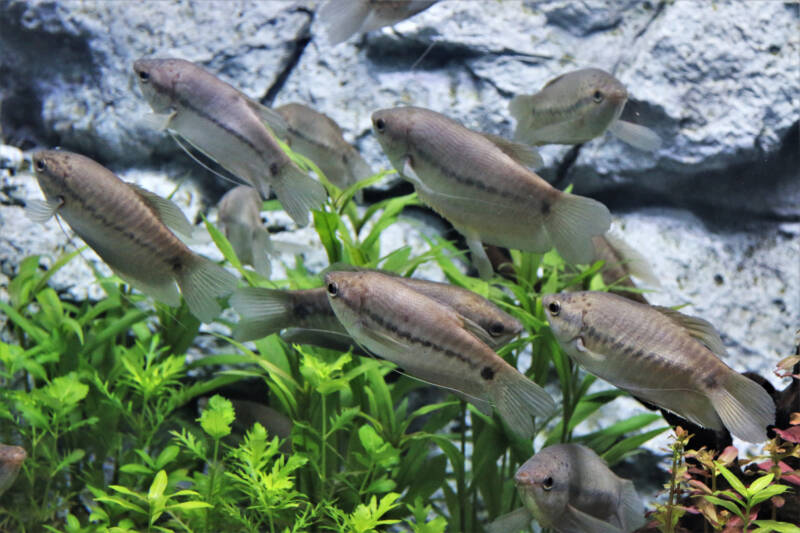
- Difficulty: Easy
- Temperament: Peaceful
- Diet: Omnivore
- Tank Size: 30 gal (114 l)
Snakeskin gouramis don’t have as much flair and drama as other types of gouramis. (Probably why they end up on menus)
They have a brown marbled pattern interspersed with green iridescence, similar to a python – hence their name.
Unlike other types of gouramis, they retain their peaceful nature, even through courtship and spawning.
Snakeskins might be more popular on the table in Asia, but they’re slowly increasing in popularity in aquariums elsewhere.
Snakeskin gouramis reach a stunning 10 inches (25 cm) in the wild.
In aquariums, expect to see an average of around 7 inches (18 cm).
Provide extra space if you bring home a pair, though, because females produce 7,000 eggs for those bubble nests!
10. Sparkling Gourami (Trichopsis pumila)
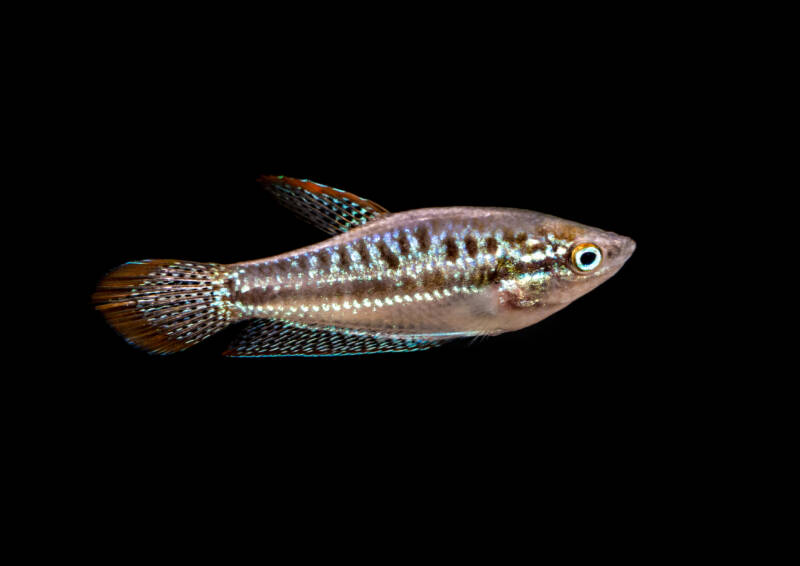
- Difficulty: Easy
- Temperament: Peaceful
- Diet: Omnivore
- Tank Size: 10 gal (38 l)
What would you expect from a name like sparkling gourami?
These tiny fish SHINE! The gold scales feature iridescent spots of red, blue, and green. Catch them under just the right lighting, and they look stunning.
Sparkling gouramis are also known as dwarf croaking gouramis.
They’re the only type of gourami capable of producing a sound audible to humans. They stretch the tendons in their pectoral fins, creating a “croaking” sound.
At just 1.5 inches (3.8 cm), sparkling gouramis make great choices for nano aquariums.
They get along well with similar-sized fish, such as smaller members of the tetra group or corydoras.
Make sure to baffle your filter, though, as they can’t handle the extra water flow.
11. Three-Spot Gourami (Trichogaster trichopterus)
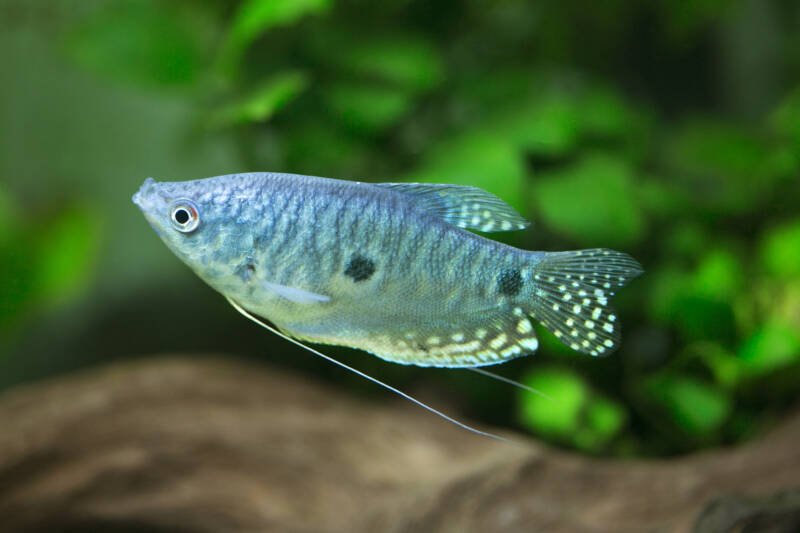
- Difficulty: Easy
- Temperament: Semi-Aggressive
- Diet: Omnivore
- Tank Size: 30 gal (114 l)
The name “three-spot gourami” tends to throw people a bit.
It’s easy enough to pick out the spot near the tail, and who can miss the one in the middle of the body. So where’s the third? It turns out scientists have a sense of humor: the third spot’s the eye.
Three-spot gouramis come in a few different color types, including opaline, gold, and blue.
They’re also one of the larger types of gouramis out there, reaching 6 inches (15.2cm) in length as adults. The two combine to make a beautiful aquarium addition.
Unhappily, three-spots can end up turning into bullies within community tanks. They love to torment fish with flowing fins.
If you want to maintain a peaceful aquarium, pair them with larger loaches, semi-aggressive cichlids, or at least fast-swimming fish.
Water Parameters: Feeling Your Way Around
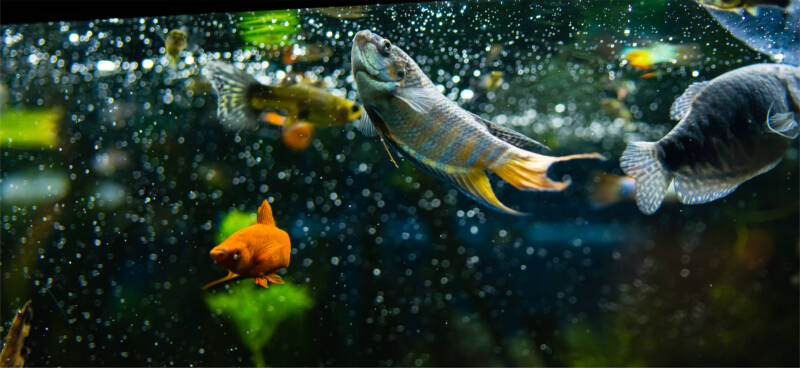
Shallow waters don’t equate to an unobstructed view. The opposite is more prevalent.
To cope with the mud-screen, gouramis developed long feeler barbs on the end of their pelvic fins. The pelvic fins rest on a mobile pivot, allowing the barbs to swing around as the fish swims.
Similar to a catfish’s whiskers, the feeler barbs probe the surrounding environment to gather information.
They can’t register smell or taste the way a catfish’s feelers can, but they help the gourami prevent mid-water collisions.
Of course, those feelers present a challenge when keeping gouramis in community tanks. Fish that develop a nasty habit of nipping at trailing fins find the barbs a temptation.
Always make sure you provide shoaling fish appropriate schools to stave off that bad habit.
| Species | Temperature | pH | Hardness | Nitrites | Ammonia | Nitrates |
| Chocolate Gourami | 75-86°F
(24-30°C) |
6.0-7.6 | 5-6dH | 0ppm | 0ppm | <10ppm |
| Dwarf Gourami | 77-82°F
(25-28°C) |
6.0-9.0 | 5-20dH | 0ppm | 0ppm | <40ppm |
| Honey Gourami | 72-82°F
(22-28°C) |
6.0-7.5 | 4-15dH | 0ppm | 0ppm | <20ppm |
| Kissing Gourami | 72-82°F
(22-28°C) |
6.5-8.5 | 5-20dH | 0ppm | 0ppm | <10ppm |
| Licorice Gourami | 75-84°F
(24-29°C) |
6.0-7.2 | 0-10dH | 0ppm | 0ppm | <10ppm |
| Moonlight Gourami | 79-86°F
(26-30°C) |
6.0-7.0 | 2-25dH | 0ppm | 0ppm | <20ppm |
| Paradise Gourami | 61-79°F
(16-26°C) |
5.8-8.0 | 5-30dH | 0ppm | 0ppm | <10ppm |
| Pearl Gourami | 75-86°F
(24-30°C) |
6.5-8.0 | 5-18dH | 0ppm | 0ppm | <20ppm |
| Snakeskin Gourami | 72-86F
(22-30°C) |
5.8-8.5 | 2-30dH | 0ppm | 0ppm | <10ppm |
| Sparkling Gourami | 72-80°F
(22-27°C) |
6.0-7.0 | 4-10dH | 0ppm | 0ppm | <5ppm |
| Three-Spot Gourami | 75-86°F
(24-30°C) |
6.5-8.0 | 5-18dH | 0ppm | 0ppm | <10ppm |
As you might notice, gouramis don’t tolerate nitrites, ammonia, or nitrates.
You may see behaviors such as fins pressed close to their sides or your fish lying flat on the bottom of the tank.
Both are cause for alarm, and you’ll want to check your water quality immediately.
To Plant or Not to Plant?
Gouramis come in a variety of colors and patterns.
Males and females differ in their designs, allowing you to create an aquarium of shifting color. And colors show to the most advantage in a beautifully planted tank.
If you’re worried about your gouramis devouring the greenery, you can rest easy. Most types of gouramis lean toward the carnivorous side of the menu.
You might see them nibbling at the plant fronds, but they’re trying to remove aquatic insects and fry, not the leaves.
As males, in particular, get territorial with each other, plants and other decorations can create individual pockets to solve the problem of heightened aggression.
You can carve your tank into designated territories, keeping everyone calm and happy.
Dim the Lights
Most types of gouramis come from areas of shallow water in the wild. They aren’t used to intense lighting conditions. Nor do they thrive in regions with crystal clear waters.
You don’t want an aquarium with a heavy silt burden, but you want your fish to stay healthy.
Mimicking a dim, darkened water environment is simple:
- Add almond leaves to the tank to provide natural plant tannins.
- Consider floating plants to dim the overhead light.
- Choose low light plants, such as Java ferns, so you can keep your lights turned down.
- Sink natural driftwood to provide hiding places.
Gourami Health
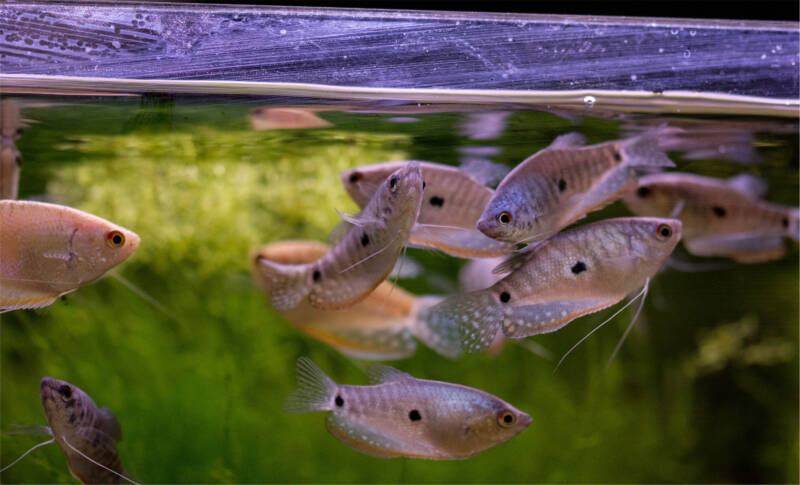
Keeping your tank cycled and performing weekly water changes suit all types of gouramis.
They may thrive in shallow ditches in the wild, but they’re susceptible to disease when water conditions slip out of control.
Some of the most common health conditions you’ll want to keep an eye out for include:
- Dwarf Gourami Disease: This viral infection targets more than gouramis. The virus causes unusual behavioral changes, such as spontaneous rapid swimming in circles. Your fish will also lose weight and develop reddish spots along their sides. It’s FATAL, and there’s no cure.
- Ichthyobodo necator: That’s right – the vile Ich. Aquarists recognize the typical white spots of this parasitic flagellate.
- Fin Rot: A bacterial infection, fin rot causes your gourami’s beautiful fins to look ragged and torn. Since these labyrinth fish can hold their own against bullies, odds are no one’s chewing on them. Get your fish checked out by a vet.
- Fungal Infections: Gouramis kept in poor water conditions develop fungal growths on their scales, fins, gill covers, and even their eyes. Make sure you’re using clean water sources.
- Flukes: Poor food sources allow parasitic worm eggs to hitchhike into your tank. The worms continue to develop inside your gouramis. High-quality foods prevent fluke infestations in your aquarium.
Except for dwarf gourami disease, you can treat these common problems with medication and improvement of your tank’s water quality.
However, prevention beats treatment any day, so focus on keeping your aquarium clean and your food the best.
Graceful Gouramis
Gouramis venture into all of the levels of the water column. Their varied colors and patterns add stunning arrays of vibrancy to aquariums of every size.
You’ll find yourself discussing their unique features with every visitor to your home as people get drawn to their flashing activity.
Do you keep a tank with gouramis? Have you glimpsed that air-breathing routine?
Share your gourami stories here!
